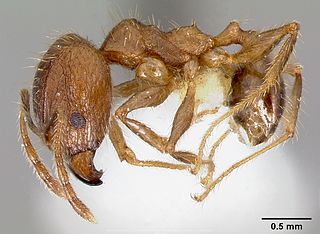
Mayotte, officially the Department of Mayotte, is an overseas department and region and single territorial collectivity of France. It is located in the northern part of the Mozambique Channel in the Indian Ocean off the coast of Southeastern Africa, between Northwestern Madagascar and Northeastern Mozambique. Mayotte consists of a main island, Grande-Terre, a smaller island, Petite-Terre, as well as several islets around these two. Mayotte is the most prosperous territory in the Mozambique Channel, making it a major destination for immigration.

Pheidole is a genus of ants that belongs to the ant subfamily Myrmicinae. The genus is widespread and ecologically dominant. It probably includes more than 1000 species. The genus first evolved in the Americas, eventually spreading across the globe.

The Comoro Islands or the Comoros are an archipelago of volcanic islands situated off the southeastern coast of Africa, to the east of Mozambique and northwest of Madagascar. The islands are politically divided between the Union of the Comoros, a sovereign country, and Mayotte, an Overseas Department of France.
This article is one of a series providing information about endemism among birds in the world's various zoogeographic zones. For an overview of this subject see Endemism in birds.

Leptomyrmex, or spider ants, is a genus of ants and a distinctive member of the ant subfamily Dolichoderinae. Commonly known as "spider ants" for their long legs and spider-like movements, these orange and black ants are prominent residents of intact wet forest and sclerophyll habitats throughout their range. One extant species, Leptomyrmex relictus, is known from central Brazil; otherwise, the global distribution of this genus is restricted to eastern Australia, New Caledonia and New Guinea, as well as the nearby Indonesian islands of Aru and Seram.

The Comoros forests is a terrestrial ecoregion which covers the Comoro Islands, which lie in the Mozambique Channel between Madagascar and East Africa. These include four main islands: Grande Comore, Anjouan and Mohéli, of the Union of the Comoros, and Mayotte, a department and region of France.

Miniopterus griveaudi is a bat in the genus Miniopterus found on Grande Comore and Anjouan in the Comoros and in northern and western Madagascar. First described in 1959 from Grande Comore as a subspecies of the mainland African M. minor, it was later placed with the Malagasy M. manavi. However, morphological and molecular studies published in 2008 and 2009 indicated that M. manavi as then defined contained five distinct, unrelated species, and M. griveaudi was redefined as a species occurring on both Madagascar and the Comoros.
Pheidole komori is a species of ant in the subfamily Myrmicinae.
Pheidole parva is a species of ant in the subfamily Myrmicinae.
Pheidole ragnax is a species of ant in the subfamily Myrmicinae.

Pheidole fervens is a species of ant in the subfamily Myrmicinae. Pheidole fervens, described from Singapore, is a widespread invasive species and could be native to the Oriental or the Oceanic region.

Pheidole teneriffana is a species of ant in the subfamily Myrmicinae.
Pheidole dodo is a species of ant in the subfamily Myrmicinae. It is named after the dodo, an extinct bird of Mauritius.
Pheidole megatron is a species of ant in the subfamily Myrmicinae.

Pheidole braueri is a species of ant in the subfamily Myrmicinae.
Pheidole loki is a species of ant in the subfamily Myrmicinae.
Pheidole decepticon is a species of ant in the subfamily Myrmicinae.
Pheidole vulcan is a species of ant in the subfamily Myrmicinae.
Pristomyrmex tsujii is a species of ant in the genus Pristomyrmex. Known from Fiji, where they are widely distributed but rarely encountered. The species has a discrete ergatoid queen caste that is intermediate between a worker and an alate queen.










